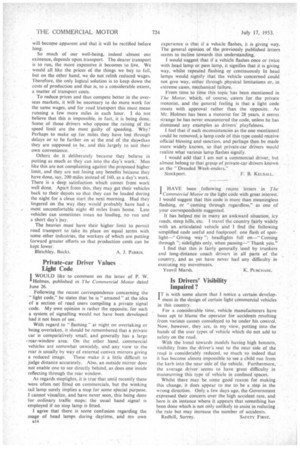Private-car Driver Values Light Code
Page 48

If you've noticed an error in this article please click here to report it so we can fix it.
I WOULD like to comment on the letter of P. W. Holmes, published in The Commercial Motor dated June 26_
Following the recent correspondence concerning the "tight code," he states that he is " amazed" at the idea of a section of road users compiling a private signal code. My own opinion is rather the opposite, for such a system of signalling would not have been developed had it not been of use.
With regard to " flashing " at night on overtaking or being overtaken, it should be remembered that a private car is comparatively small, and generally has a large 'rear-window area. On the other hand, commercial vehicles are somewhat unwieldy, and any view to the rear is usually by way of external convex mirrors giving a reduced image. These make it a little difficult to judge distance accurately. Also, an outside mirror does not enable one to see directly behind, as does one inside reflecting through the rear window.
As regards stoplights, it is true that until recently these were often not fitted on commercials, but the winking tail lamp surely implies a stop for some special purpose. 1 cannot visualize, and have never seen, this being done for ordinary traffic stops; the usual hand signal is employed if no stop lamp is fitted.
I agree that there is some confusion regarding the usage of head lamps during daytime, and my own s14




















































































